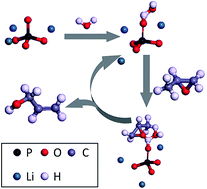Steam treatment of a hollow lithium phosphate catalyst: enhancing carbon deposition resistance and improving the catalytic performance of propylene oxide rearrangement†
Abstract
Carbon deposition is a great problem for most solid acid and base catalysts applied in organic catalytic reactions. Basic lithium phosphate catalyst, when used for propylene oxide rearrangement, is also easily deactivated due to carbon deposition. In this paper, a green surface modification technique of steam treatment was employed to suppress carbon deposition on the basic lithium phosphate catalyst and to improve its catalytic performance. The results showed that the catalyst which was pre-treated with steam at 300 °C for 30 minutes exhibited excellent catalytic activity. Furthermore, the amount of carbon deposition was 15.1%, much lower than that of the untreated catalyst (21.5%). The steam treatment could increase the amount of hydroxyl and adjust the distribution of the acid and base sites. The decrease of the amount of Brønsted acid sites resulted in the reduction of carbon deposition. The enhancement of activity could be attributed to the increase of synergistic sites, and this could be due to an increase in the amount of Lewis acid sites and in the strength of the base sites.


 Please wait while we load your content...
Please wait while we load your content...